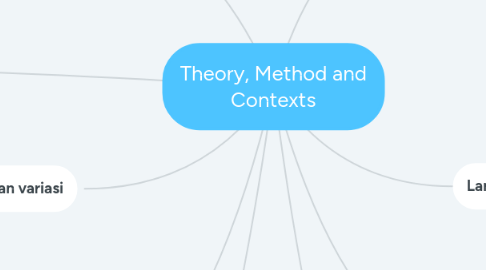Theory, Method and Contexts
Luluatul AwaliyahMSにより

1. Accent
1.1. The feature commonly used as a criterion in talking about variation is ‘accent’. Accent refers, in addition to the pronunciation of sounds, to stress and intonation, or to the rhythm of speech. Just like variety, accent also leads to controversies about which one is superior, desirable, and so on.
2. Varieties of the English world
2.1. The commonly accepted and considered 'legitimate' varieties of English for educational purposes worldwide are American and English English. Other varieties, Australia, Canada and New Zealand
3. Difusi dan variasi
4. External models in the Outer and Expanding Circles
4.1. ideological,
4.1.1. Marckwardt (1942: 309) wrote that ‘the acceptance as a standard of one type of speech over another is based not upon linguistic considerations but rather upon political, cultural, and economic factors’.
4.2. Expanding Circles on the basis of arguments
4.2.1. First, a uniform standard world-wide is essential for maintaining ‘world English’ as a viable means of communication (a lingua franca).
4.2.2. Second, there are already varieties that have been codified after extensive and intensive research.
4.2.3. Third, the relationship between language and culture is organic
4.2.4. Fourth, the case in favour of regional norms, such as South Asian, African, South-East Asian, etc., reflects ‘liberation linguistics’ ideologies and is motivated by considerations of power.
5. Ideological perspectives
5.1. Phillipson (1992: 17 ff.) asserts that ‘[t]he advance of English, whether in Britain, North America, South Africa, Australia or New Zealand has invariably been at the expense of other languages’,
6. how to conceptualize pluricentricity is to look at a world that uses English in three concentrations
6.1. (The inner circle) comprises the ‘mother country’ England and the British Isles and the areas where the speakers from Britain took the language with them as they migrated Australia, New Zealand and North America.
6.2. The Outer Circle comprises the countries where the language was transplanted by a few colonial administrators, businessmen, educators, and missionaries, and is now nurtured by the vast majority of indigenous multilingual users. They use English as an additional.
6.3. The expanding Circle People's Republic of China, Japan, Korea, Thailand, European countries, Middle East, and Latin America
7. Language, dialect and variety
7.1. In the US, there are dialects like African-American Vernacular English
7.2. In England, the dialect is known as Cockney has a class base: Trudgill
7.3. In South Asia, there are dialect differences based on caste and religion. There are dialects that are identified with both religion and caste.
8. Standards
8.1. the concepts of Standard British English and General American English
9. Internal models in the Outer and Expanding Circles
9.1. First, the development of American English and now the progressive movement towards claims of independent status demonstrate that acculturation of language to new contexts is unavoidable.
9.2. Second, languages do not owe their existence to codification, they exist because they are used by people.
9.3. Third, as users of English keep enlarging its range and depth in the Outer and Expanding Circles and the language becomes acculturated and transforms itself into localized varieties
9.4. Fourth, it is worth repeating the point that, ultimately, the issue of standard has more to do with power and ideology than with language
9.5. Fifth, as for the increasing differentiation among varieties and issues of intelligibility


